Children of African descent in Latin America
Work area(s)
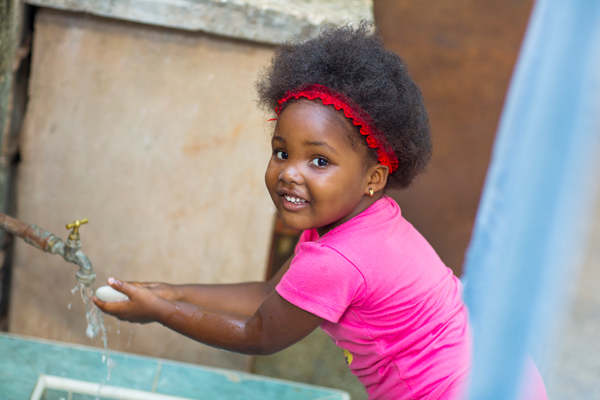
Laís Abramo and Marta Rangel[1]
The history of Latin America is closely related to European colonization, conquest and slavery. The latter consisted both of the enslavement of part of the indigenous population and, in particular, of African people trafficked intercontinentally[2]. The slave system lasted in the region for almost 400 years and has left deep marks in our societies. These include the structural inequalities that affect Afrodescendent populations and the persistence and reproduction of racism and ethnic and racial discrimination manifested in different areas of development and rights, such as health, education, work, social protection and the possibility of living a life free of violence.
The inheritance of the colonial and slave past and the reproduction of inequality and racial discrimination through cultural structures, institutions, practices and patterns in force until today, explain why racial inequality is one of the structuring axes of the matrix of the social inequality in Latin America, along with socioeconomic, gender, territorial and age inequalities (ECLAC, 2016c). These inequalities not only add up, but intersect, enhance and chain throughout the life cycle. The analysis of the situation of Afrodescendent children in Latin America demonstrates the intersection of racial inequalities and those based on people’s age. The evidence indicates significant deficiencies, gaps and violations of rights in fundamental areas of development and well-being of this group, both in terms of basic health and nutrition indicators, as well as in access to education, basic infrastructure services and the possibility of living a life free of violence, in safe environments and with effective opportunities for upward social mobility and personal fulfillment. Even considering that the available statistics are insufficient to adequately measure racial inequalities in most Latin American countries and in all dimensions of social development and the rights agenda that should be considered, the data show the long road that exists so that children of African descent are not left behind in the path of development and so that their rights are guaranteed. [3]
I. The population of African descent in Latin America
According to ECLAC, in 2015 the Afrodescendent population [4]of the region amounted to 130 million people, representing 21.1% of the total population. This figure is a conservative estimate because, despite recent advances,[5] a significant deficit of regular and reliable statistics on these populations persists in most countries of the region (ECLAC, 2017a and 2017c).
Statistical invisibility can be considered another manifestation of the lack of recognition of Afrodescendent populations and, therefore, such visibility is part of the recognition demands of these groups.
The demands for disaggregated information by ethnic-racial condition gained strength since the Durban Conference from which the Durban Declaration and Program of Action (2001) emanated. In that instance, countries were recommended to redouble their efforts to have official data on people of African descent to evaluate and formulate policies aimed at this population. In addition, the disaggregation of data by ethnic-racial condition is part of the 2030 Agenda for Sustainable Development[6] and is expressly established in the Montevideo Consensus on Population and Development and the Decade for People of African Descent (ECLAC, 2017a). Therefore, a necessary requirement to identify the condition of African descent is to include questions of ethnic-racial self-identification in all data sources (ECLAC, 2010; Del Popolo and Schkolnik, 2013). This is still a pending task in the region, especially with regard to multi-purpose household surveys, employment surveys and administrative records.
II. Severe racial inequalities in childhood and adolescence
From a life cycle perspective,[7] characterizing the situation of Afrodescendent children implies reflecting on the way in which racial inequalities in Latin America intersect with those based on age. This perspective, increasingly considered in the discussion of public policies in Latin America, especially those of social protection, incorporates not only age and its interaction with other structuring axes of inequality, but also helps to identify the chain of inequalities in each stage of people’s lives, as well as the main factors that in each of them contribute to the reproduction of inequality or open opportunities to reduce or overcome them (Cecchini and others, 2015). It is a perspective that identifies inequalities between people located in different stages of the life cycle and also those existing between people at the same stage (ECLAC, 2017a). Likewise, these inequalities are related to sociodemographic, socioeconomic, gender and territorial inequalities.
A. Some context indicators
It is necessary to consider that the situation of children depends largely on the situation of the households in which they live. Consequently, some context elements about the situation of people of African descent will be presented. Despite a significant process of poverty and extreme poverty reduction in Latin America between 2002 and 2014, as well as the income inequality measured by the Gini coefficient (ECLAC, 2019), significant racial inequalities persist in these indicators. In four of the five countries for which information is available (Brazil, Ecuador, Peru and Uruguay), the rates of poverty and extreme poverty among Afrodescendants are significantly higher (ECLAC, 2017a and 2017c). Similarly, the proportion of Afrodescendants in the lowest income quintile was significantly higher than the proportion of non-Afrodescendants. Conversely, the percentage of non-Afrodescendent population in the highest income quintile is much higher than that of the Afrodescendent population. With regard specifically to children, this situation is even more serious, since in 2016 the overrepresentation of the Afrodescendent population aged 0 to 14 in the first income quintile was much more marked than in the population in general; in particular, in Uruguay and Brazil (figure 1). In the first country, 71% of total Afrodescendent children aged 0 to 14 were in the first income quintile, compared with 48% of the non-Afrodescendent population of the same age group; In Brazil, these figures reached 54% and 32%, respectively (Abramo, 2019).
Figure 1
Latin America (5 countries): percentage distribution of the Afrodescendent and non-Afrodescendent population aged 0 to 14 yearsa, according to the household per capita income quintile, circa 2016
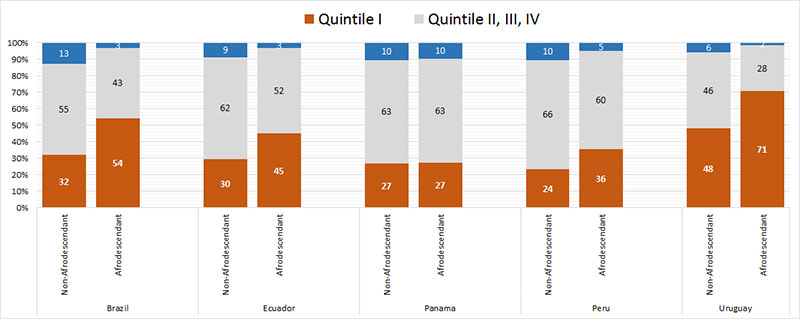
Source: L. Abramo (2019), based on special tabulations of household surveys of the respective countries conducted by the Economic Commission for Latin America and the Caribbean (ECLAC).
aIn the non-Afrodescendent population, the population that identifies itself as indigenous or the cases in which ethnic-racial status is ignored is not included.
The question on ethnic-racial self-identification was not included in 2016 for children under 14 in the household survey in Peru or to children under 5 in Ecuador. Given the need to have information for the entire population, it was decided to use a proxy indicator for children’s ethnic-racial status in these countries, for which an imputation algorithm that contemplated the kinship of children regarding the person who heads the home, the family nucleus to which they belong, the coexistence or not with both parents and the similar or different ethnic-racial classification of the parents, among other parameters.
In turn, the inequalities related to access to the labour market and the quality of the labour insertion of Afrodescendent adults also strongly condition their chances of overcoming situations of poverty and, therefore, of guaranteeing adequate levels of life to his/her sons and daughters. As already shown, unemployment, one of the main indicators of labour market exclusion, affects more women, young people, indigenous peoples and Afrodescendent populations and, in particular, women and young people of these groups (IPEA, 2011; ECLAC/UNFPA, 2011; ECLAC, 2013 and 2016c; Guimarães, 2012; Borges, 2004). In this sense and considering the population aged 15 years and over in Brazil, Ecuador, Panama and Uruguay, the unemployment rate of Afrodescendants around 2016 was significantly higher than that of non-Afrodescendants in all cases. The most pronounced gap was observed in Ecuador, followed by Uruguay, Panama and Brazil. In addition, in all countries considered, unemployment rates were significantly higher among women of African descent (Abramo, 2019).
Finally, when analyzing the labour income per hour worked, even when it is controlled by the level of education, it is appreciated that Afrodescendent women are systematically placed in the lower positions of the income scale, and non-Afrodescendent males in more favorable situations (ECLAC, 2016b, 2017a, 2017c and 2018b). Thus, for example, among people employed with tertiary education, Afrodescendent women receive an hourly income equivalent to 58% of that received by non-Afrodescendent men. Gaps like these certainly have an impact on the welfare gaps experienced by the children in their care (ECLAC, 2017a y 2017c).
1. Inequalities in basic health indicators
The overrepresentation of the population of African descent, especially children in situations of poverty and extreme poverty, and the greater difficulties of accessing decent work in their homes directly affect their health conditions, generating significant differences in the levels of mortality and life expectancy, among others. Health inequity is linked to deep, unfair and avoidable social inequalities, which can be overcome through appropriate and timely interventions (ECLAC, 2017a, and 2017c).
Census data show, for a group of eight countries (Argentina, Brazil, Colombia, Costa Rica, Ecuador, Panama, Uruguay and the Bolivarian Republic of Venezuela), that the infant mortality rate estimated for the Afrodescendent population for 2010 varies between 10 per 1,000 live births in Costa Rica and 26 per 1,000 live births in Colombia (table 1). Regardless of the values assumed by the rate, the probability that an Afrodescendent child dies before reaching one year of age is higher than that of non-Afrodescendents in all the countries considered, with the exception of Argentina. The largest gaps are recorded in Colombia, Uruguay, Panama and Brazil, countries where the aforementioned probability varies between 1.6 and 1.3 times the value corresponding to non-Afrodescendent children. Likewise, infant mortality of the Afrodescendent population is always higher, both in cities and in the countryside, with the exception of Argentina (ECLAC, 2017a y 2017c).
Table 1
Latin America (8 countries): estimates of infant mortality, by ethnic-racial conditiona and residence area, 2010
(In numbers per 1,000 live births)
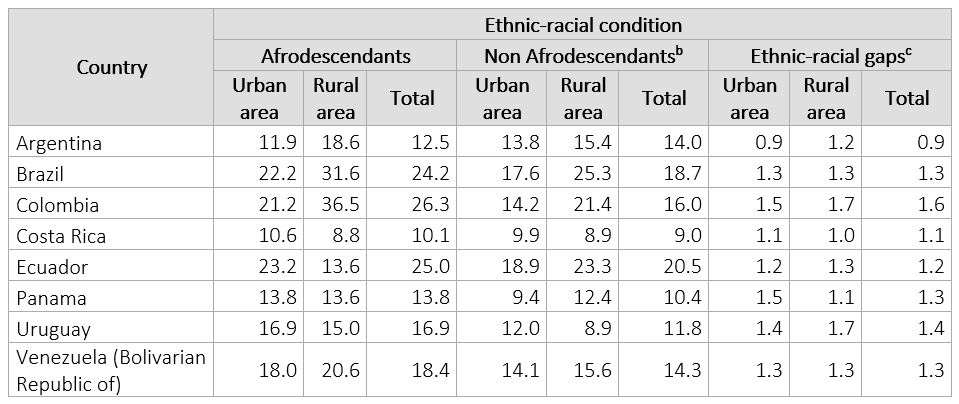
Source: Economic Commission for Latin America and the Caribbean (ECLAC) 2017a and 2018a based on indirect estimates based on census microdata.
a Estimates were obtained through indirect demographic methods and a final adjustment of the level of mortality, based on the official figures in force for the national total, according to the Demographic Observatory, 2016. Population Projections (ECLAC, 2017c).
b The non-Afrodescendent population does not include the population that identifies itself as indigenous or the cases in which ethnic-racial status is ignored.
c Ratio between infant mortality of the Afrodescendent and non-Afrodescendent population.
It is unfortunate that the interactions between socioeconomic factors and nearby determinants of infant mortality, as well as the quality of health care delivered, frequently affected by discriminatory practices,[8] have been poorly studied for Afrodescendent populations. In addition, in certain contexts, it is very important to promote a cultural adaptation of health services in which knowledge and practices of African roots are integrated, which occurs infrequently (ECLAC, 2017a, 2017b y 2017c).
Another highly stratified phenomenon in the region is teenage pregnancy, much more pronounced among people with fewer resources, in rural areas and among indigenous and Afrodescendent populations (ECLAC, 2017a, 2017b and 2017c). Teen pregnancy is a major obstacle to the conclusion of the educational trajectory and, therefore, for future employment opportunities for young people and adults. Generational and gender interbreeding in terms of sexual and reproductive rights is more pressing when the ethnic-racial factor is added. This requires an adequate intervention of public policies, first because the fertility rate in adolescence has not decreased in the same way as the global fertility rate and has even increased in some countries in certain periods. Secondly, because pregnancy at an early age is associated with socioeconomic inequalities, since their frequency is much more pronounced among people in poverty and with lower educational levels, among which Afrodescendants are overrepresented. Likewise, it is related to gender inequality, since parenting and care fall mainly on young women, their mothers and grandmothers, regardless of their marital status or cohabitation with the baby’s father (Rodríguez, 2014).
On the basis of census information from the beginning of the 2010s, it is possible to observe that the percentage of Afrodescendent adolescents between 15 and 19 years who were mothers in 8 of 11 countries[9] exceeds that of non-Afrodescendents (figure 2). In all these countries, between 14% and 30% of Afrodescendent adolescents had already had at least one child and the highest proportions were in Ecuador and in the Plurinational State of Bolivia. Gaps are also observed in Brazil and Uruguay, showing that even countries with lower levels of poverty and that have implemented comprehensive and universal health policies have not been able to eliminate ethnic-racial inequality in this indicator (ECLAC, 2017a, 2017b y 2017c).
Figure 2
Latin America (11 countries): proportion of adolescents between 15 and 19 years who are mothers, by ethnic-racial conditiona, around 2010 (Percentages)
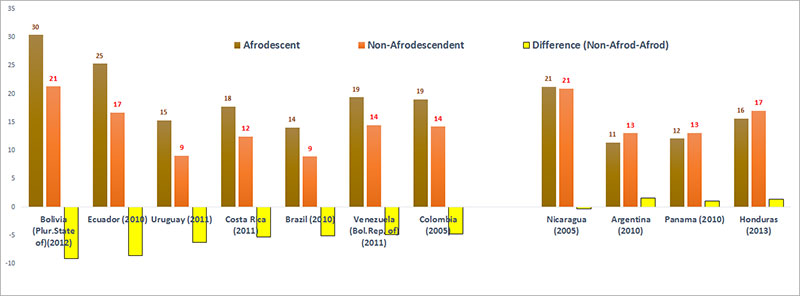
Source: L. Abramo (2019), on the basis of special processing of census microdata through REDATAM 7 conducted by the Economic Commission for Latin America and the Caribbean (ECLAC).
a In the non-Afrodescendent population, the population that identifies itself as indigenous or in which ethnic-racial status is ignored is not included.
Finally, another situation related to health and well-being and which seriously violates the Afrodescendent population are violent deaths. In Latin America there is abundant evidence that young people are highly affected by the phenomenon of violence, which is one of the main factors that contribute to the disease burden of this stage of life, especially among males (Trucco and Ullmann, 2015).[10] Racial status introduces an additional factor to this reality: Afrodescendants, particularly young people, are at greater risk of being searched in the street due to police controls with racist bias and are detained, imprisoned and sentenced to more severe penalties.[11] Of the total number of victims of homicides in Brazil in 2017, 75.5% were Afrodescendants and women of African descent represented 66% of the total number of victims of homicide in the same period (IPEA, 2019).[12] Likewise, for adolescents and young male of African descent between 12 and 29 years, the risk of exposure to violence was significantly higher than the risk to which people of the same age group who identified themselves as white were exposed: in 2012, the relative risk of a young Afrodescendent of being a victim of homicide was 2.6 times greater than that of a young white male (Brazil, 2014 cited by IPEA, 2017). In turn, in Brazil, young Afrodescendent women of ages between 15 and 29 were 2.2 times more likely to be killed than white women of the same age group (Brazil, 2017, cited by Gomes and Laborne, 2018).
Likewise, in the case of Colombia, the violence suffered by Afro-Colombian women in the context of armed conflict and population displacement includes sexual violence, torture, forced disappearance, death threats and intimidation. In 2014, 563 thousand Afrodescendent victims were registered; of these, 52.2% were women and 58.7% were under 26 years of age (Articulación Regional Feminista de Derechos Humanos y Justicia de Género, 2015 cited by ECLAC, 2017c). Similarly, in the departments of Cali and the Valley of Colombia, the higher death rate of the young and adolescent population was evident, affecting Afrodescendants in greater proportions (Urrea-Giraldo and others, 2015).
2. The right to education is crucial for the integral development of children of African descent
The guarantee of the right to quality education is fundamental for all people and, especially, for children, adolescents and young people. It is also crucial to achieve increased productivity and innovation, economic growth and social change oriented towards equality and sustainable development, particularly in contexts of accelerated technological change. In addition, the right to education facilitates the realization of other rights, the State being the guarantor and responsible for implementing policies that ensure compliance.
In Latin America there have been notable advances in terms of expanding coverage and access to education in recent decades. However, important challenges remain, such as fostering the incorporation of the most excluded groups (extremely poor, rural people, indigenous peoples and people of African descent), access to pre-school education, secondary and tertiary education and the conclusion of those last two levels, in addition to the improvement of the quality of education (Trucco, 2014).
On the other hand, completing secondary education is essential not only to acquire the basic skills that a globalized world requires and that will allow people to develop freely and with the ability to learn throughout their lives, but also to access minimum levels of well-being that allow to break the mechanisms of reproduction of inequality (Trucco, 2014). However, access to this level is much lower than that of basic education and, among those who do not finish high school, there are more young people who belong to lower income households, who live in rural areas and who identify themselves as indigenous and/or Afrodescendants. Of the 11 countries in the region for which information is available, in 7 of them the school attendance of children of African descent between 12 and 17 years was lower than that of non-Afrodescendants (figure 3). The relative gaps were higher in Uruguay, Ecuador and Venezuela (Bolivarian Republic of), although the differences were not as wide and girls had somewhat higher attendance rates than boys.
Figure 3
Latin America (11 countries): proportion of children between 12 and 17 years attending an educational establishment, by ethnic-racial condition and area of residence, around 2010 (Percentages)
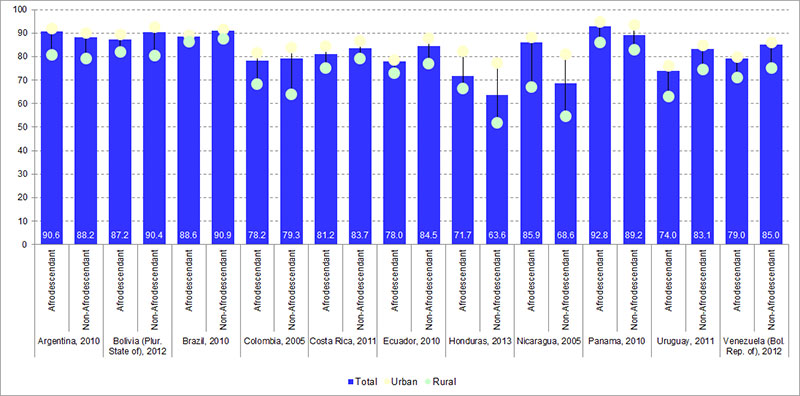
Source: Economic Commission for Latin America (ECLAC) on the basis of special processing of census microdata through REDATAM7, 2017.
Note: In the non-Afrodescendent population, the population that identifies itself as indigenous or the cases in which ethnic-racial status is ignored is not included.
Gaps by racial condition are higher when considering the percentage of young people aged 20 to 24 who have completed secondary education. With data from household surveys it is possible to analyze more up-to-date information (around 2016) for five countries (Brazil, Ecuador, Panama, Peru and Uruguay). Figure 4 shows significant unfavorable gaps for Afrodescendent populations in all of them (24 percentage points in Uruguay, 18 percentage points in Peru, 16 in Ecuador and 14 in Brazil), with the exception of Panama (less than 1 percentage point) (Abramo, 2019).
Figure 4
Latin America (5 countries): population aged 20 to 24 years with complete secondary education by ethnic-racial conditiona, around 2016 (Percentages)
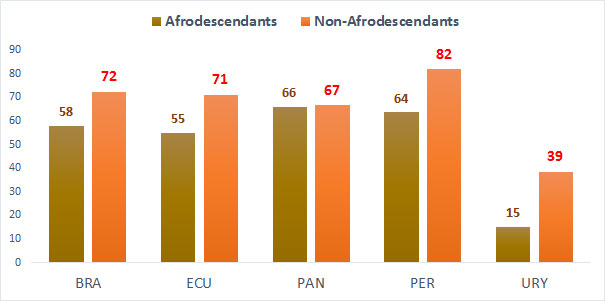
Source: L. Abramo (2019), based on special tabulations of household surveys of each country conducted by the Economic Commission for Latin America and the Caribbean (ECLAC).
a In the non-Afrodescendent population, the population that identifies itself as indigenous or the cases in which ethnic-racial status is ignored is not included.
There are also significant gaps by ethnic-racial status in relation to school lag rates in the population between 15 and 19 years evidenced by household surveys in four countries. In Brazil and Uruguay, the gaps are high (greater than 9 percentage points in the case of men) while in Panama they are lower (in the order of 2 percentage points) (table 2). In turn, it is observed that school lag is always higher in men, both in the case of Afrodescendants and non-Afrodescendants.
Table 2
Latin America (4 countries): population between 15 and 19 years with school lag according to ethnic-racial condition and sex, around 2016 (Percentages)

Source: L. Abramo (2019), based on special tabulations of household surveys of each country conducted by the Economic Commission for Latin America and the Caribbean (ECLAC).
a Difference in the proportion of men compared to women.
b Difference between the proportion of the Afrodescendent and non-indigenous or Afrodescendent population.
In the non-Afro-descendent population, the population that identifies itself as indigenous or the cases in which ethnic-racial status is ignored is not included.
Finally, it is necessary to point out that these values, although they allow to know the degree of compliance with the right of access to education, are insufficient to assess their quality. Racial inequalities and structural and institutional racism continue to manifest themselves through the limited existence of culturally relevant educational policies, the lack of participation mechanisms and the lack of affirmative action policies (ECLAC, 2017a and 2018c). In addition, the school as an institution should contribute to the construction of self-recognition and recognition of others contemplating and assessing the Afrodescendent component as part of the history of each country (Corbetta and others, 2018).
III. Main challenges
It is imperative to safeguard and guarantee the rights of children of African descent. This happens, first of all, by its recognition and statistical visibility in official information systems, such as censuses, multi-purpose household surveys, demographic and health surveys, administrative records of programs and social policies, among others. The available information shows that ethnic-racial inequality continues to be a structural feature of Latin American societies and an expression of discrimination, racism and the culture of privileges that still persist and reproduce in various ways. In most of the countries for which information is available which, as noted in this article, is still insufficient to account for the multiple aspects of inequality, discrimination and violation of the rights of children of African descent, the Afrodescendent population has higher rates of infant mortality and teenage pregnancy, as well as less access to education (particularly at secondary and tertiary levels) and decent work. It is also a victim of violence in a much higher proportion than the non-Afrodescendent or indigenous population. The intersection of ethnic-racial, age and gender inequalities demonstrates the seriousness of the situation experienced by children and young people of African descent. In addition, the analysis of inequalities also reveals that, even in countries with higher levels of welfare for the national population and lower levels of poverty and income concentration (for example, Uruguay), or that have universal policies (for example, Brazil and Uruguay in the field of health), there are still significant racial inequalities.
Therefore, it is central to consolidate recognition processes and promote knowledge of the history of the Afrodescendent population in Latin America and the Caribbean and their contribution to the construction and the economic, political, social, cultural and historical development of our countries through, for example, its inclusion in school curricula.[13] Likewise, it is urgent to make progress in the design and implementation of policies that, based on the proposal of a universalism that is sensitive to differences and the urgent need to move from the culture of privilege to the culture of equality, advance specifically in overcoming the invisibility of the Afrodescendent population in its design and implementation, in the abolition of all forms of discrimination that may persist in its design, in the introduction of affirmative action mechanisms and in the guarantee of the rights of people of African descent and, especially for children of African descent. Among the priority policy areas, comprehensive attention to early childhood is highlighted; health and nutrition of childhood and adolescence; extension of the coverage of quality preschool education; universalization of primary and secondary education; incorporation of intercultural practices in educational systems and school curricula and actions to prevent and accelerate the rate of abolition of child labour through social protection policies with a child-sensitive perspective. In this sense, the 2030 Agenda for Sustainable Development and the International Decade of People of African Descent constitute, at the same time, a great challenge and a great opportunity for children in Latin America and the Caribbean not to "be left behind” in the path of inclusive social development and sustainable development in general.
Bibliography
Abramo, L. (2019), “Niños, niñas y adolescentes afrodescendientes en América Latina: el entrecruzamiento de diversas dimensiones de la desigualdad social” en Departamento de Afrodescendencia del MIDES (Ministerio de Desarrollo Social de Uruguay), Construyendo políticas públicas hacia los niños, niñas y adolescentes afrodescendientes de las Américas y el Caribe, Montevideo.
OHCHR (Office of the High Commissioner for Human Rights) (2019), “Preventing and Countering Racial Profiling of People of African Descent. Good Practices and Challenges”
Bárcena, A. y A. Prado (2016), El imperativo de la igualdad. Por un desarrollo sostenible en América Latina y el Caribe, CEPAL, Siglo Veintiuno Editores, Argentina.
Borges, R. (2004), “Desigualdades raciais e políticas de inclusão racial: um sumário da experiência brasileira recente”, serie Políticas Sociales, N° 82 (LC/L.2082-P), Santiago, Comisión Económica para América Latina y el Caribe (CEPAL).
BRASIL (2017), “Índice de vulnerabilidade juvenil à violência 2017: desigualdade racial, municípios com mais de 100 mil habitantes”, Secretaria de Governo da Presidência da República, Secretaria Nacional de Juventude e Fórum Brasileiro de Segurança Pública. São Paulo: Fórum Brasileiro de Segurança Pública.
Cecchini, S. and others (2015), Towards universal social protection: Latin American pathways and policy tools (LC/G.2644-P), Santiago, Economic Commission for Latin America and the Caribbean (ECLAC).
ECLAC (Economic Commission for Latin America and the Caribbean) (2019), Social Panorama of Latin America 2018 (LC/PUB.2019/3-P), Santiago.
___(2018a), Social Panorama of Latin America 2017 (LC/PUB.2018/1-P), Santiago.
___(2018b), The inefficiency of inequality (LC/SES.37/3-P), Santiago.
___(2018c), Towards a regional agenda for inclusive social development: Bases and initial proposal (LC/MDS.2/2), Santiago.
___(2017a), Social Panorama of Latin America 2016 (LC/PUB.2017/12-P), Santiago.
___(2017b), Linkages between the social and production spheres: Gaps, pillars and challenges (LC/CDS.2/3), Santiago.
___(2017c), Situación de las personas afrodescendientes en América Latina y desafíos de políticas para la garantía de sus derechos, Documentos de proyectos (LC/TS.2017/121), Santiago.
___(2016a), Social Panorama of Latin America 2015 (LC/G.2691-P), Santiago.
___(2016b), The social inequality matrix in Latin America (LC/G.2690 (MDS.1/2)), Santiago.
___(2016c), Horizons 2030: Equality at the centre of sustainable development, (LC/G.2660/ Rev.1), Santiago.
___(2013), Mujeres indígenas en América Latina: dinámicas demográficas y sociales en el marco de los derechos humanos, Documentos de Proyecto (LC/W.558), Santiago, Comisión Económica para América Latina y el Caribe (CEPAL).
___(2010), Social Panorama of Latin America 2009, (LC/G.2423-P), Santiago.
ECLAC/UNFPA (Economic Commision for Latin America and the Caribbean/ United Nations Population Fund) (2011), “Juventud afrodescendiente en América Latina: realidades diversas y derechos (in)cumplidos”, Santiago.
Corbetta, S. and others (2018), “Educación intercultural bilingüe y enfoque de interculturalidad en los sistemas educativos latinoamericanos: avances y desafíos”, serie Documents Projects (LC/TS.2018/98), Santiago, Economic Commision for Latin America and the Caribbean (ECLAC) and United Nations Children´s Fund (UNICEF).
Defensoría del Pueblo del Ecuador (2012), “El pueblo afrodescendiente en el Ecuador. Informe temático”, Quito.
Del Popolo, F. y S. Schkolnik (2013), “Pueblos indígenas y afrodescendientes en los censos 2010 de América Latina: avances y desafíos en el derecho a la información”, Notas de Población, N° 97 (LC/G.2598-P), Santiago de Chile, Economic Commission for Latin America and the Caribbean (ECLAC). United Nations publication.
Gomes, N.L y A.M. de P. Laborne (2018), “Pedagogia da crueldade: racismo e extermínio da juventude negra”, Educação em Revista, N° 34, e197406.
Guimarães, J.R.S. (2012), “Perfil do trabalho decente no Brasil: um olhar sobre as Unidades da Federacão durante a segunda metade da década de 2000”, Brasilia, Organización Internacional del Trabajo (OIT).
Hurtado-Saa, T., R. Rosas-Vargas and A. Valdés-Cobos (2012), “Servicios de salud, discriminación y condición étnica/racial: un estudio de caso de la problemática en México y Colombia”, Revista Ra Ximhai, vol. 9, N° 1, Universidad Autónoma Indígena de México (UAIM).
IBGE (Instituto Brasileño de Geografía y Estadística) (2015), “Síntese de Indicadores Sociais 2015 – uma análise das condições de vida da população brasileira”, Estudos e Pesquisas N° 35, Brasilia.
IPEA/FBSP (Instituto de Pesquisa Econômica Aplicada/Fórum Brasileiro de Segurança Pública) (2019), Atlas da violencia 2019, Rio de Janeiro. Atlas da violencia 2019, Rio de Janeiro.
___(2017), Atlas da violencia 2017, Rio de Janeiro.
___(2011), Retrato das desigualdades de gênero e raça, Río de Janeiro.
Mallú, P. y otros (2013), “Discriminação racial no cuidado em saúde reprodutiva na percepção de mulheres”, Texto Contexto – Enfermagem, vol. 22, N° 2, Florianópolis.
UN (United Nations) (2001), “Report of the World Conference against Racism, Racial Discrimination, Xenophobia and Related Intolerance”.
Rangel, M. (2019), “Políticas de acción afirmativa: la experiencia brasileña en educación superior” (en imprenta).
Rodríguez, J. (2014), “Fecundidad adolescente en América Latina: una actualización”, en S. Cavenaghi y W. Cabella (coords.), Comportamiento reproductivo y fecundidad en América Latina: una agenda inconclusa, Río de Janeiro, Asociación Latinoamericana de Población (ALAP).
Trucco, D. (2014), “Educación y desigualdad en América Latina”, serie Políticas Sociales N° 200, serie Projects documents (LC/L. 3846), Santiago, Economic Commission for Latin America and the Caribbean (ECLAC).
Trucco, D. and H. Ullmann (2015), Youth: realities and challenges for achieving development with equality (LC/G.2647-P), Santiago, Economic Commission for Latin America and the Caribbean (ECLAC).
UNESCO (United Nations Educational, Scientific and Cultural Organization) (2010),“Slave Routes: A Global Vision”.
Urrea-Giraldo, F. y otros (2015), “Patrones de mortalidad comparativos entre la población afrodescendiente y la blanca-mestiza para Cali y el Valle”, Revista CS, N° 16.
[1] The authors appreciate Vivian Milosavljevic’s collaboration in the data processing.
[2] It is estimated that between 1500 and 1867, about 12.5 million people were enslaved and moved from Africa to America and that almost half of this traffic occurred in the 18th century, making up the largest transoceanic deportation commercial enterprise in history (UNESCO, 2010).
[3] An important part of the data and analysis presented in this text is based on recent ECLAC production on the subject (ECLAC, 2016c, 2017a, 2017b and 2018a) and in Abramo (2019).
[4] The Afrodescendent concept refers to the descendants of the African diaspora in the world and was coined in 2001 during the preparation of the World Conference against Racism, Racial Discrimination, Xenophobia and Related Intolerance in Durban. In Latin America and the Caribbean, the concept acquires particular connotation, since it refers to the different black or African-American populations that were formed from the descendants of Africans who survived trafficking or transatlantic slave trade between the 16th and 19th centuries. This also includes people of African descent or Africans who are currently moving to the countries of the region through intra or interregional migratory movements (ECLAC, 2017a y 2017c).
[5]Of the 14 Latin American countries that have conducted the censuses of the 2010s, a total of 13 included questions of self-identification of people of African descent (Argentina, Bolivia (Plurinational State of), Brazil, Colombia, Costa Rica, Cuba, Ecuador, Guatemala, Honduras, Panama, Paraguay, Peru, Uruguay and Venezuela(Bolivarian Republic of)). Although El Salvador and Nicaragua have not yet carried out the censuses of this decade, they plan to include the self-identification of the Afrodescendent population and Mexico included questions about it in the 2015 Intercensal Survey. Therefore, the challenge of including self-identification Afrodescendants are still pending in the censuses of Chile, Haiti and the Dominican Republic. In turn, the countries that incorporate the self-identification of the Afrodescendent population in their multi-purpose household surveys are Brazil, Colombia, Ecuador, Panama, Peru and Uruguay; however, data from Colombia was not available at the time of the preparation of this article. In 2013, the Plurinational State of Bolivia included the “Afro-Bolivian” answer alternative in the question regarding ethnic self-identification, but the number of people who identified themselves with that category was very small, so it was not possible to work with that information (ECLAC, 2017a).
[6] Target 17.18 of the 2030 Agenda states: “By 2020, improve the provision of capacity-building support to developing countries, including least developed countries and small island developing States, with a view to increasing significantly the availability of timely, reliable and high quality data disaggregated by income groups, gender, age, race, ethnicity, immigration status, disability, geographic location and other relevant characteristics in national contexts”. Although the 2030 Agenda does not explicitly refer to the Afrodescendent population, the mention of the disaggregation of data by race and ethnic origin and, mainly, its purpose of “leaving no one behind” forces the consideration of the groups that face various forms of vulnerability, exclusion and discrimination, among which is the Afrodescendent population.
[7] Traditionally, four basic stages of the life cycle are distinguished: childhood and adolescence, youth, adulthood and old age. However, there are no standardized age definitions, and, in some cases, they overlap. For example, although the Convention on the Rights of the Child (United Nations, 1989) defines the child stage up to 17 years of age, youth is often defined from 15 years. In addition to the difficulty of defining the stages by age, their meaning varies according to the context, since it is a social construction (ECLAC, 2017a and 2017c). Also, within these stages there are internal divisions (such as early childhood, puberty, adolescence, young adults, senior citizens) with important differences among them.
[8] See, for example, Hurtado-Saa, Rosas-Vargas and Valdés-Cobos (2012); Ombudsman of Ecuador (2012) and Mallú and others (2013).
[9] The countries are Argentina, Bolivia (Plurinational State), Brazil, Colombia, Costa Rica, Ecuador, Honduras, Nicaragua, Panama, Uruguay and Venezuela (Bolivarian Republic of).
[10] For example, in Brazil in 2017, the homicide rate of the general population was approximately 31.6 deaths per one hundred thousand inhabitants, while that of the total number of young people (15 to 24 years of age) was 69.9 and that of young males reached 130.4 per one hundred thousand inhabitants, that is, more than four times the rate of the total population. See IPEA (2019) available [online]
[11] This practice, known as “racial profiling,” characterizes police attitudes of detention and control that use racist biases unconsciously or deliberately. Certain groups of the population, especially young people of African descent, are subjected to various forms of violent treatment without a legitimate objective of law enforcement. Such attitudes may be the result of racism rooted in society and in police institutions. The program of activities of the UN Afrodescendent Decade calls on States to take measures to eliminate this phenomenon (OHCHR, 2019).
[12] The data also show that the gap between the homicide rates of the Afrodescendent and non-Afrodescendent population has been experiencing a growing trend: between 2007 and 2017, the homicide rate increased 33.1% for the Afrodescendent population and 3.3% (10 times less) for the non-Afrodescendent population. As a result, in 2017 that rate was 43.1 per hundred thousand people among the Afrodescendent population and 16.0 per thousand people among the non-Afrodescendent population. In the case of women, in the same period, the homicide rate of Afrodescendants grew 29.9%, while that of non-Afrodescendants grew 4.5%. Available [online]
[13] In relation to this, we can mention the experience of Brazil with Law No. 10.639/2003 that changes the Guidelines and Bases of Education Law to include the discipline of Afro-Brazilian History and Culture in the school curriculum and that of Colombia, with Decree No. 1,122 (1998), which issues standards for the development of the Afro-Colombian Studies Professorship in all formal education establishments in the country, as part of the compulsory curricula.